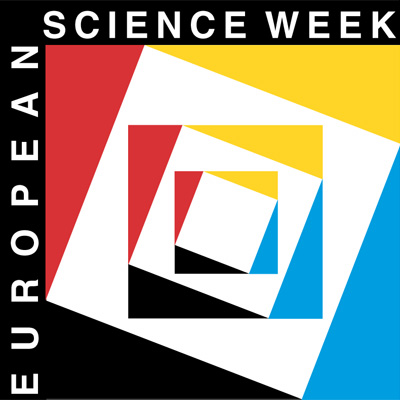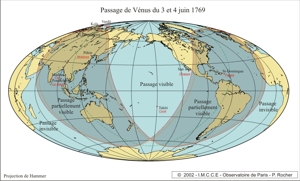

The Venus Transit 2004
... Extended InfoSheet F3
History of transit observing
3. The 1769 transit of Venus

Visibility of the transit of 1769 (Hammer)
Experience gained from the 1761 transit was used to improve methods for the 1769 transit. Lalande organized the French astronomers and Pingré searched for favourable observing sites. Le Gentil stayed in Madagascar, then went first to Manila and finally to Pondichery where a fatal cloud cheated him of any observation. "C'est là, le sort qui attend souvent lesAstronomes. J'avois fait près de dix mille lieues; il sembloit que je m'avois parcouru un si grand espace de mers, enm'exilant de ma patrie que pour être spectateur d'un nuage fatal, qui vint se présenter devant le Soleil au moment précis de mon observation, pour m'enlever le fruit de mes peines et de mes fatigues " (Note 1).
Chappe, accompanied by a surveyor Pauly, an artist Noël and a clockmaker Dubois as well as two Spanish astronomers Vicente de Doz and El Salvador de Medina, went to Baha California on the west coast of Mexico, close to Cape Lucas to a Spanish mission which now bears the name San José del Cabo. The observation of the transit by Chappe and his collaborators was a success and they stayed there to observe an eclipse of the Moon on June 18, 1769 in order to determine precisely the longitude of their site. However, they succumbed to an epidemic of typhus which decimated three-quarters of the population. Only Pauly and Noël survived the epidemic.
The third French expedition was a sea voyage of which the goal was not only to observe the transit of Venus but also to test marine clocks invented by Berthoud. Pingré and the Comte deFleurieu who sponsored the voyage, observed the transit of Venus from Cape François in St Domingo.
In England the observation of the 1769 transit was planned energetically. James Ferguson had described the coming transit in the Philosophical Transactions in 1763 and two years later Thomas Hornsby published an important report on the advisability of observing the transit. "In this uncertainty, the astronomers of the present age are peculiarly fortunate in being able so soon to have recourse to another transit of Venus in 1769, when, on account of that planet's north latitude, a difference in the total duration may conveniently be observed, greater than could possibly be obtained, or was even expected by Dr Halley from the last transit".
In November 1767, a special committee was set up to prepare for the transit. The committee decided to send three teams of observers. The first team, composed of Dymond and Wales, went to Fort Churchill on Hudson's Bay. The second team, trained by Father Maximilan Hell, assisted by the Danish astronomer C.Horrebow and a young botanist Borgrewing, was to go to Vardö, a small island on the north of the Scandinavian peninsula and the third team was to go to the South Seas Islands as had been suggested by Thomas Hornsby.
This last expedition was also used to explore the South Seas and was entrusted to a young unknown lieutenant, James Cook. The observation of the transit of Venus was to be made on Tahiti, an island discovered two years previously by Samuel Wallis. The Tahiti observation was carried out by Charles Green and James Cook.
To these three teams it is necessary to add Bayley and Dixon; Bayley observed the transit at the North Cape and Dixon observed it on the Norwegian island of Hammerfest. In addition to these observations, there were also about ninety made in the British colonies in America as suggested by Winthrop, the only American observer in 1761.
On the suggestion of Czarina Catherine II, the imperial Academy of Russia invited many foreign astronomers to observe the transit of Venus. They included the Jesuit C. Mayer from Germany, the astronomers Mallet and Pictet fromSwitzerland and J. Lexell from Sweden, as well as the famous mathematician Leonard Euler. Russia sent these observersto many sites distributed over its vast territory (Yakutsk, Orks and Orenburg in the south of the Urals, the Cola peninsula and St Petersburg).
Although England was third in the number of observations of the earlier transit, it came first with 69 distinct observations at the 1769 transit. France followed with only 34 observations, which marked a decline of the scientific dominance ofFrance in Europe. In total, the 1769 transit involved 151 professional observing teams distributed over 77 sites. In spite of the many more instruments used for the observations, (27 achromatic refractors - there were only three for the observation of the transit of 1761), the observations did not provide a definitive value of the solar parallax. Moreover, it has to be acknowledged that this observational campaign had many fatalities, not only in Chappe's team in Mexico but also during Captain Cook's voyage.
The following table gives the various values found for the solar
parallax following these observations.
| Authors | Values |
| William Smith | 8.6045" (1770) |
| Thomas Hornsby | 8.78" (1770) |
| Pingré et Lalande | 9.2" et 8.88" (1770) |
| Pingré | 8.80" (1772) |
| Lalande | between 8.55" and 8.63" (1771) |
| Planmann | 8.43" (1772) |
| Hell | 8.70" (1773/1774) |
| Lexell | 8.68" (1771) and 8.63" (1772) |
One can deduce that the parallax lies between 8.43"and 8.80", which is a clear improvement compared to the values obtained after the first transit with values ranging between 8.28"and 10.60".
The reduction of the transit observations of 1761 and 1769 was repeated afterwards by J.F. Encke in 1824 and S. Newcomb in 1890.
Note 1: "That's a fate which often befalls astronomers. I had travelled nearly ten thousand miles; it seemed that I had crossed a great expanse of ocean and had left my homeland only to be the spectator of a fatal cloud, which appeared in front of the Sun at the precise moment of my observation, to snatch from me the reward of my sorrows and my tiredness."
Go to the corresponding Brief InfoSheet
Back to the List of Extended InfoSheets.